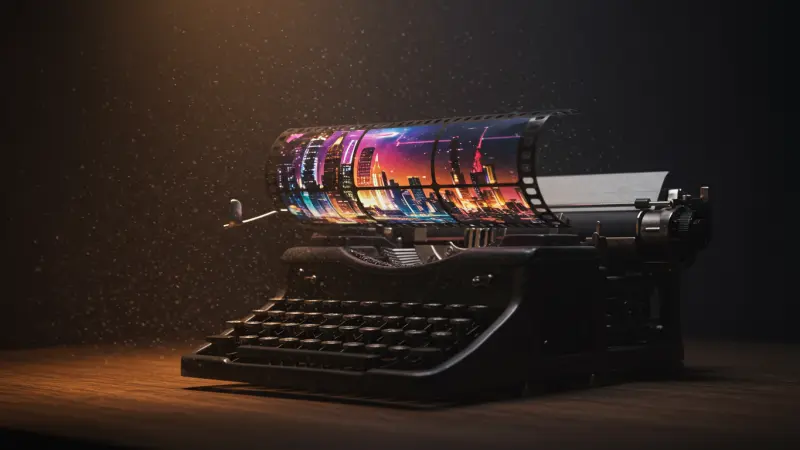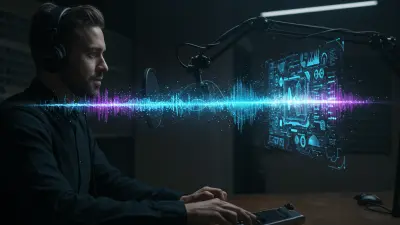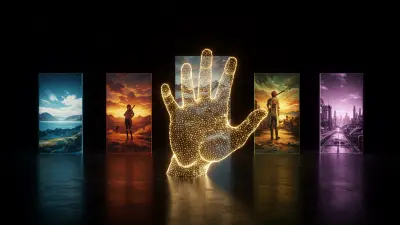How to Create a Full Video from a Single Text Prompt (Step-by-Step)

The Future of Filmmaking is Here: Turning Words into Worlds
Imagine describing a scene in your mind—a majestic dragon soaring over a futuristic city at sunset, a quiet café on a rainy Parisian street, or a time-lapse of a flower blooming in hyper-detail—and watching it materialize as a high-definition video moments later. This isn't science fiction anymore. This is the power of generative AI for video, a technology that is fundamentally changing the landscape of content creation, marketing, and storytelling. With just a single text prompt, you can now direct, shoot, and produce entire video clips, opening up a universe of creative possibilities that were once the exclusive domain of professional studios.
But how does it actually work? How do you go from a simple sentence to a compelling, coherent video? This guide will walk you through the entire process, step-by-step. We'll demystify the art of prompt crafting, explore the nuances of different AI models, and provide you with the practical knowledge to start creating your own stunning videos from text today.
First, What is AI Text-to-Video Generation?
At its core, AI text-to-video generation is a process where a sophisticated artificial intelligence model interprets a written description (a "prompt") and generates a sequence of images that form a video clip. These models have been trained on vast datasets of videos and their corresponding textual descriptions, allowing them to learn the complex relationships between words, objects, actions, and visual styles.
Think of it like an incredibly talented, infinitely fast animator who can instantly understand your vision. When you type "a golden retriever puppy chasing a red ball in a sunny park," the AI doesn't just see words; it understands the concepts of "puppy," "chasing," "red ball," and "sunny park" and knows how to visually represent them in motion. Pioneers in this space, like OpenAI's Sora, Runway, and Pika Labs, are pushing the boundaries of what's possible, generating clips with remarkable coherence, detail, and cinematic quality.
Understanding the Core Concepts Before You Begin
Before jumping into the step-by-step process, it's crucial to grasp a few key concepts that will dramatically improve your results.
What Makes a Good Prompt? The Art of Description
The prompt is your script, your director's notes, and your cinematographer's brief all rolled into one. A vague prompt will yield a vague video. A detailed prompt is your key to a masterpiece. A great prompt typically includes:
- Subject: The main character or object of your video (e.g., "a wise old owl," "a sleek sports car").
- Action: What the subject is doing (e.g., "perched on a branch and turning its head," "speeding through a mountain pass").
- Environment: The setting and background details (e.g., "in an enchanted moonlit forest," "at golden hour with lens flare").
- Style & Mood: The overall aesthetic and feeling (e.g., "in the style of a Ghibli anime, peaceful and serene," "cinematic, dramatic, high-contrast lighting").
- Camera Shot: The perspective of the viewer (e.g., "extreme close-up shot," "wide-angle drone footage," "handheld camera shot").
The Role of the AI Model
Each AI video generator has its own unique 'personality.' Some might excel at realistic human characters, while others are masters of fantastical landscapes or anime styles. They interpret prompts differently based on their training data. Part of the process is learning the language of your chosen tool and understanding its strengths and weaknesses. What works perfectly on one platform may need tweaking on another.
Current Limitations and Challenges
While the technology is breathtaking, it's not perfect. Be aware of common challenges like maintaining character consistency across multiple clips, generating realistic hands or complex movements, and avoiding strange visual artifacts. Video length is also a current limitation, with most generators producing clips of only a few seconds. The key is to work with these limitations, often by generating multiple short clips and editing them together.
Step-by-Step Guide: How to Create a Full Video from a Single Text Prompt
Ready to create? Follow these steps to bring your vision to life.
-
Step 1: Choose Your AI Video Generator
The market is exploding with options. When choosing a tool, consider factors like video quality, ease of use, pricing, available styles, and specific features (like camera controls or image-to-video capabilities). Some are browser-based, while others operate within platforms like Discord. Do some research, watch comparison videos, and find the one that best suits your creative goals and budget.
-
Step 2: Craft Your Master Prompt
This is the most critical step. Let's build a powerful prompt from scratch using the principles we discussed. Instead of just "a man walking," let's build something far more evocative.
- Start with the Subject & Action: "An old man with a long white beard and a tweed coat is walking slowly."
- Add the Environment: "An old man with a long white beard and a tweed coat is walking slowly along a cobblestone path in a foggy, Victorian-era London."
- Define the Camera Shot & Style: "Cinematic wide shot of an old man with a long white beard and a tweed coat walking slowly along a cobblestone path in a foggy, Victorian-era London. The streetlights cast a warm, hazy glow."
- Set the Mood & Details: "Cinematic wide shot, moody and mysterious. An old man with a long white beard and a tattered tweed coat walks slowly along a wet cobblestone path in a foggy, gaslit Victorian-era London. The streetlights cast a warm, hazy glow, reflecting off the puddles. Hyperrealistic, 8k, detailed."
See the difference? The final prompt gives the AI a rich tapestry of information to work with, dramatically increasing the chances of a high-quality, specific output.
-
Step 3: Generate and Iterate
Input your prompt into the generator and wait for the magic to happen. Your first result might be 90% of what you wanted, but not perfect. Don't be discouraged! This is part of the creative process. Analyze the output. Is the lighting wrong? Is the movement too fast? Tweak your prompt and try again. For example, you might change "walking slowly" to "shuffling cautiously" or add "ominous mood" to change the feeling. Iteration is key to refinement.
-
Step 4: Chaining Prompts for Longer Narratives
To create a video longer than a few seconds, you need to think in scenes. Create a sequence of prompts that logically follow each other. For our Victorian example, your sequence might be:
- Clip 1 (Establishing Shot): The detailed prompt we created above.
- Clip 2 (Close-up): "Medium close-up shot of the old man's face, his expression is weary, looking off-camera. Same style and lighting."
- Clip 3 (Point of View): "Point-of-view shot, looking down at the man's worn leather boots stepping on the wet cobblestones."
- Clip 4 (The Reveal): "The man stops and looks up at a shadowy figure in a doorway. Dramatic reveal."
By generating these four clips, you've created a narrative sequence that tells a small story.
-
Step 5: Post-Production and Final Polish
Once you have your generated clips, import them into a traditional video editing software (like CapCut, DaVinci Resolve, or Adobe Premiere Pro). This is where you assemble your final video. You can:
- Arrange and trim your clips to control the pacing.
- Add transitions for a seamless flow between scenes.
- Incorporate sound design and a music score to build atmosphere.
- Add voice-overs or text overlays to enhance the narrative.
- Color grade the footage to ensure a consistent look across all clips.
This final step elevates your AI-generated clips into a polished, professional-looking video.
Pro Tips for Truly Cinematic AI Videos
Ready to level up? Here are some advanced tips used by the pros:
- Think Like a Filmmaker: Don't just describe a scene; think about the emotional impact you want to create. Use filmmaking language in your prompts, like "dolly zoom," "rack focus," or "low-angle shot."
- Use Negative Prompts: Many tools allow for negative prompts (e.g., `--no blurry, deformed`). Use this feature to tell the AI what you don't want, helping to clean up your output and remove common errors.
- Master Aspect Ratios: Need a vertical video for TikTok or a widescreen video for YouTube? Specify the aspect ratio (e.g., `--ar 9:16` or `--ar 16:9`) in your prompt to get the right format from the start.
- Leverage Seed Numbers: Some platforms use a "seed" number to generate randomness. If you find a generation you like, reusing its seed number while making small tweaks to the prompt can help you maintain consistency in the character and environment.
- Study the AI's Output: Pay close attention to the videos the tool creates. Notice what it does well and what it struggles with. Tailor your creative ideas to its strengths for the best results.
Explore Hundreds of AI Tools
Ready to find the perfect tool for your needs? Browse our complete, filterable directory of the best AI software on the market.
Browse the DirectoryConclusion: Your Creative Journey Starts Now
Creating a full video from a single text prompt is no longer a futuristic dream but a tangible, accessible reality. By combining the art of descriptive language with the power of cutting-edge technology, you can bypass traditional production hurdles and bring your most imaginative ideas to life with unprecedented speed and ease. The process is a unique blend of technical skill and creative intuition—learning to communicate your vision to a digital collaborator.
Remember that the key lies in detailed prompts, a willingness to iterate, and a filmmaker's eye for storytelling. The tools are evolving at a dizzying pace, and what's challenging today may be effortless tomorrow. So, dive in, start experimenting, and don't be afraid to push the boundaries. The blank prompt box is your new canvas. What world will you create first?
About Paul Peery
Founder of Best AI Powered

